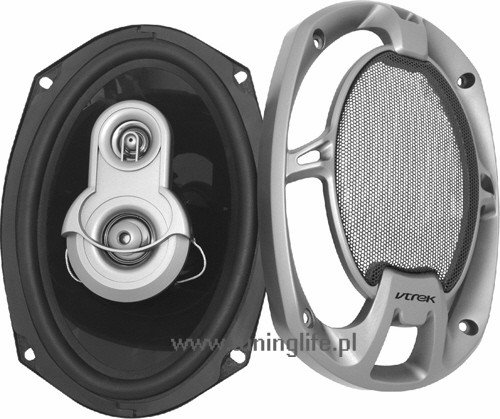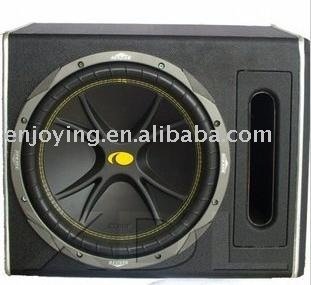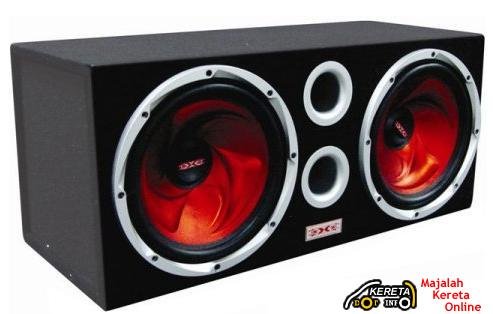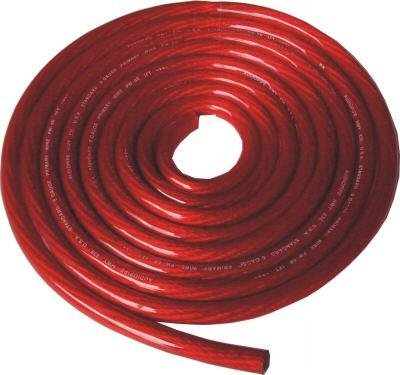Do amp.s come as part of the factory fitted stereo systems of Maruti, ford etc.?
Not at all! Only some high end cars like Audis with Bang Olufsen setup come with amps. Mitsubishis like outlander & montero with Rockford Fosgate system may have an amp as it comes with a 8" subwoofer as standard.
Manufacturers offer a very basic system like a simple HU with 1 pre out & pretty basic co-axials in front & rear. some cars do have tweeters but again they dont have crossovers. this is done obviously to save costs but then components can change the music quality tremendously. hence i advise everyone to install atleast comps in the front with an amp.
before i forget, subwoofers basically come in 3 sizes- 8", 12" & 15". some manufacturers also give the sub with their box (JBL), but that would be expensive to buy. Also, another type of sub is
Shallow Mount sub which has a very small cone, so that they can be fitted in small/slim boxes. useful in cars where owners dont want to sacrifice their boot space or they want the sub under a seat. such subs are pretty expensive.
Some info from the net (source: Crutchfield):
AWG
American Wire Gauge (AWG) is the standard for measuring the diameter of electrical wires and cables. The smaller the AWG number, the larger the wire. Because of their high current demands, car amplifiers need large power wires to get enough energy from the battery to operate correctly. The more wattage an amplifier has, the larger the wires that power it need to be. 8-gauge and 4-gauge wires are commonly used sizes for powering car amplifiers.
Bridged Power
When you bridge an amplifier, you combine the power output of two channels into one channel. Bridging allows you to drive one speaker with more power than the amp could produce for two speakers. Because of this high power output, bridging is an ideal way to drive a single subwoofer.
If your amp is bridgeable, the owner's manual will have directions that tell you how. Usually, an amp is bridged by connecting the speaker leads to the positive (+) terminal from one channel and the negative (-) terminal from the other channel. However, you should be sure to consult your owner's manual before attempting to bridge your amp.
Also, keep in mind that most amplifiers need to see a 4-ohm load when bridged to mono operation. If you want to bridge your amp, you should use one 4-ohm speaker or, if you prefer multiple woofers, wire two 8-ohm speakers in parallel. (Again, consult your manual before operating your amp in bridged mode.)
Bass Boost Circuitry
Increases the output of low frequencies. Usually centered somewhere between 40 and 90 Hz, many amps have variably controlled circuits that allow you to increase the bass level in dB increments (ie. 0-12 dB at 45Hz). Variable bass boosts allow you to adjust the center frequency, changing the character of the bass.
Built-in Crossovers
Crossovers consist of both a high-pass and low-pass filter. Often used to keep high-frequencies from reaching a subwoofer, a low-pass filter allows only frequencies below the crossover point to be amplified. A high-pass filter allows only frequencies above the crossover point to be amplified — useful for keeping low bass away from small speakers, so they can play more efficiently. Crossovers are usually listed as variable or selectable. Continuously Variable means the crossover can be freely adjusted to any frequency between the listed end points. Selectable means that you can choose from several preset crossover points.
Capacitor
A capacitor is an electronic component that stores and releases electrical charge. Heavy-duty capacitors are often used as a buffer zone between your amp and your car's electrical system. They store up a reservoir of power, which can supply the amplifier's peak demands (like a kick drum beat) without having to get additional current from the battery. All amplifiers have built-in capacitors, though high-performance amps use larger, more effective ones. External capacitors connect to the power cable just before it reaches your amplifier.
Classes of Amplifiers
An amplifier is classified according to its circuit design and the way its output stages are powered. Although some may assume that for every portion of the input signal there is corresponding 100% output from the amplifier, power dissipation (in the form of heat) and distortion of the audio signal are two key factors in determining the efficiency and fidelity of an amplifier. Each class has its own performance characteristics and advantages.
* Class A amplifiers are desirable for the high quality of their sound, but, because of the configuration of its transistors, a pure class A amplifier is inefficient and runs very hot. This is because even when there is no audio signal, the output transistors always have current running through them. The current flowing through the output transistors (with no audio signal) causes the amp to heat up unnecessarily, and "waste" input energy. Most car amplifiers that boast "Class A" circuitry are really Class A/Class AB hybrids.
* The output transistors of Class B amplifiers actually turn off for half of every signal cycle. This improves efficiency and saves energy, but introduces distortion during the switching periods.
* By far the most common car amp design, Class AB amplifiers also allow current to run through the output transistors when there is no audio signal, but at a much lower level. A class AB amplifier runs cooler, and therefore, more efficiently than a class A, with low distortion and high reliability.
* Class D amplifiers use output transistors as switches to control power distribution — the transistors rapidly switch on and off at least twice during every signal cycle. Class D amps boast higher efficiency, produce less heat, and draw less current than traditional Class AB designs. Class D amplifiers produce higher distortion than AB designs due to the high-speed switching on and off of the transistors, but this distortion occurs at high frequencies that are typically removed by a low-pass filter.
Mono Amplifier
Mono (or monaural) amplifiers are single channel amps, well suited for low-frequency applications since the human ear cannot distinguish stereo in the extreme bass range. Also, since mono amplifiers are stable to 2-ohms, you can connect them safely to two 4-ohm woofers (wired in parallel).
Power Handling (RMS)
The maximum continuous sine wave power that can be dissipated by a speaker without failure, measured in watts RMS. Most speakers fail for one of two main reasons:
1. A speaker is driven with too much power, beyond its rating, and it overheats.
2. The amplifier is driven into clipping, producing square wave distortion that destroys the driver.
Preamp output
Preamp outputs let you pass the preamp signal to additional amps, saving you from having to run more long patch cords to your receiver or to use unreliable y-adapters in order to hook up all your amps.
RMS Power vs. Peak Power
The amount of continuous power, measured in watts, that an amplifier produces is called RMS power. RMS ("Root Mean Square") is a mathematical way of obtaining a useful average when discussing power capabilities. The higher the RMS figure, the louder and cleaner your music sounds. When choosing an amplifier, the RMS rating is the power rating you should pay most attention to.
Also, keep in mind that some manufacturers calculate the RMS power ratings of their amplifiers at different input voltages. For example, an amplifier rated at 100 watts RMS at 12 volts can produce considerably more power than an amp rated at 100 watts RMS at the more typical 14.4 volts.
Stereo manufacturers often display peak power ratings on the face of their products. The peak power rating tells you the maximum wattage an amplifier can deliver as a brief burst during a musical peak, like a dramatic drum accent. The RMS figure is more significant and more indicative of the amp's long-term performance.
RMS Power at 2 ohms
This spec tells you how much more power your amp delivers when presented with a 2-ohm stereo load. You can achieve a 2-ohm load by using parallel wiring or by using 2-ohm speakers.
Theoretically, amp output should exactly double as the impedance drops from the usual 4 ohms to 2 ohms. However, amp makers use different degrees of regulation on power supplies, which can restrict the actual increase in output.
Less regulated power supplies come closer to doubling their output into 2-ohm loads. An amp with little regulation can achieve higher wattage into lower impedances. An amp with stiffer regulation maintains rated output from your amp as other electrical accessories demand voltage from the battery.


























![Evil [evil] [evil]](https://www.theautomotiveindia.com/forums/images/smilies/Evil.gif)

![Thumbs Up [thumbsup] [thumbsup]](https://www.theautomotiveindia.com/forums/images/smilies/Thumbs%20Up.png)